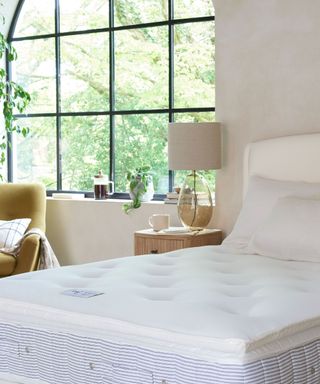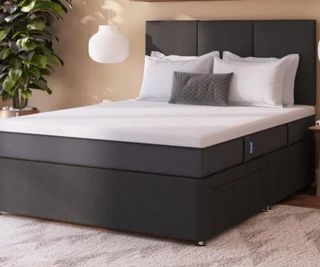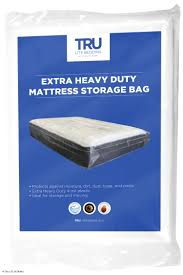How to store a mattress – expert tips to promote the perfect slumber
This is how to store a mattress to prevent damage, even in long-term storage


There are several reasons you may need to stow your mattress away. You might be moving, redecorating or renovating, or need a place to stow it before reselling it when you get a new one. But how do you store a mattress to prevent it from being damaged?
Their large size, heavy weight, and awkward materials mean mattresses are not the simplest home goods to stash away. Not even the best mattresses can be folded up and popped in a closet, after all, and improper storage could cause irreparable damage even affecting your quality of sleep should you use it again.
This is how to store a mattress properly to prevent damage and ensure you or the next owner sleep better when it's brought out again.
How to store a mattress
There is no getting around the fact that mattresses are difficult to store. Ideally, it would help to have a large, dry area of your home where it can be laid down fully with nothing placed on top of it. It also needs good air circulation to help prevent mold and musty odors that can ruin the material.
This usually means that damp basements and humid attics are out of the question unless they have been converted and/or damp-proofed. A well-insulated garage could be a good spot.
With the space sorted, this is how to keep the mattress to prevent damage.
1. Attempt to lay the mattress flat

While it is not always to lay your mattress flat, Laurie Goldsmith from REM-Fit recommends doing so where possible. 'If you have space, always store the mattress lying flat as if it was on a bed base,' they say. 'This will protect the inner workings of a sprung mattress and help it retain its shape.'
If you can not accommodate a flat mattress in your home, it could be a good idea to place the furnishing in your garage. That way, your mattress will be out of sight – meaning it is less likely to get damaged in daily life. If storing your mattress flat, consider flipping your mattress occasionally to ensure it doesn't wear out from its own weight over long periods.
2. Limit the risk of falling

If you do not have space to lay your mattress flat in a spare room or garage, you can still store the piece against the wall without damaging its strings. However, Laurie warns that this comes with extra caution.
'Depending on the mattress, it will likely start to buckle under its own weight, so check it regularly and rotate it,' Laurie says. Memory foam mattresses and latex mattresses usually fare better on their sides than other types of mattresses.
'If you have the space and a spare item of furniture available, sandwich the mattress against the wall to help keep it upright and tall,' Laurie adds. 'Be careful to make sure the item of furniture cannot fall over.'
3. Invest in a protective cover

Regardless of how you position your mattress, Laurie urges you to purchase a zipped mattress encasement to cover the furnishing throughout its storage.
This will keep your mattress fresh and protect against dust and debris that could embed into the materials and affect your sleep hygiene when used again.
Heavy Duty Mattress Moving Storage Bag | View at Walmart
This heavy-duty plastic storage bag for mattresses comes in every size you could need to keep your mattress safe in storage.
4. Check the mattress regularly

If you are storing a mattress topper or mattress for a long time, it is important to check it over for signs of damage regularly, suggests Gabriella Dyson, Solved section editor at Homes & Gardens.
'When checking on a mattress that has been stored for longer than one week, it is important to check for signs of damage such as moisture on the inside of the bag, lumps or misshapen edges, mold spots, and rips and tears,' she urges.
Spotting any of these early enough should allow you to rectify the issues before it is too late. It might be that the mattress needs to be flipped or moved entirely to a new spot if the humidity or temperature isn't right.

Gabriella Dyson is Head of Solved at Homes & Gardens, editing and writing practical advice for homeowners in the process of cleaning, decluttering, or attempting home improvements and DIY projects. Gabriella previously worked on Homebuilding.com, writing features about issues surrounding historic and listed building projects.
FAQs
How long can you store a mattress vertically?
If you have to store a mattress vertically, it should only be for a very short time as the weight of the materials can start to compress on themselves and misshape the mattress. That being said, with the right supports, such as a tight frame keeping the mattress front and back squeezed tightly together, you might get away with keeping a mattress like this for up to a year.
Generally, however, it is best to store a mattress flat without anything on top of it.
Is it okay to leave a mattress rolled up?
When a mattress arrives all rolled up, it is okay to leave it like this for a short period while you prepare your space. However, it is generally recommended that you unroll the mattress and lay it flat, allowing it to spring up to shape for 24-48 hours before use, within three weeks of arrival, to prevent permanent misshaping.
When you bring the mattress out of storage again, it is a great time to clean the mattress to remove any dust or debris that might have settled, even with a cover. Steam cleaning your mattress may also be feasible, provided it is not made of foam that may melt with the heat. Be sure to check the care label first.
Sign up to the Homes & Gardens newsletter
Decor Ideas. Project Inspiration. Expert Advice. Delivered to your inbox.

Chiana has been at Homes & Gardens for a year, having started her journey in interior journalism as part of the graduate program. She spends most of her time producing content for the Solved section of the website, helping readers get the most out of their homes through clever decluttering, cleaning, and tidying tips – many of which she tests and reviews herself in her home in Lancaster to ensure they will consistently deliver for her readers and dabbles in the latest design trends. She also has a first-class degree in Literature from Lancaster University.
- Megan SlackHead of Celebrity Style News
-
 Cracks in your concrete patio? Experts share 7 steps for DIY repair to get your yard in pristine condition for summer
Cracks in your concrete patio? Experts share 7 steps for DIY repair to get your yard in pristine condition for summerGet ready for outdoor entertaining by fixing up concrete patio damage in just a few simple steps
By Tenielle Jordison Published
-
 5 items I never throw out – and how I reuse them around my home
5 items I never throw out – and how I reuse them around my homeI share the five things I never throw out when I can help it, and reveal the five ways I reuse them around my house to help limit the impact on the environment
By Chiana Dickson Published
-
 How to elevate your teen's former bedroom into a beautiful home office
How to elevate your teen's former bedroom into a beautiful home officeTips and advice from an interior designer and a professional organizer on how to transition your teen's bedroom into a home office
By Ashley Chalmers Published
-
 Here's how to deep clean a dorm room, according to experts
Here's how to deep clean a dorm room, according to expertsCleaning experts reveal all the best ways to deep clean a dorm room, and reveal some of the most ignored spots.
By Ashley Chalmers Published
